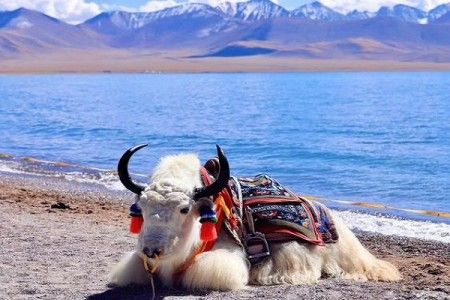Significance of Yaks for Tibetans
The yak is a symbol of the traditional Tibetan lifestyle. The reason why Tibetans call yaks "treasure" is that the yaks provide the basic guarantee for people's survival in the traditional Tibetan society. Tibetan yaks are full of treasures, and every treasure is selflessly bestowed on mankind. Its gifts benefit the people on Tibetan Plateau in terms of clothing, food, shelter, transportation, as well as burning, farming, medical treatment, recreation, and so on. It can be said that yaks contributed everything from birth to death. As the intimate companions of the Tibetans, the herders call the yak “Noor”, which means “wealth” or “treasure”.
What is a Yak?
Yak is mainly living on the Tibetan Plateau, which is used to be the main livestock species of herders. Its main characteristics are a large head, wide forehead, thick horns and long hair. In Tibetan areas, yaks are known as "boat of the plateau" and worshiped as a totem by Tibetans. It is not only an indispensable partner of the plateau life but also the protector of the clans in Tibetan myths and legends. Living in the alpine regions with an altitude of 3,000m to 5,000m, yaks can withstand the severe cold of minus 30°C to 40°C. In the snowstorm, the yak looks bold and powerful, mighty and firmly. Undoubtedly, the yak is a symbol of the strongest vitality on the plateau. It has also become a unique cultural icon of the Tibetans.
Significance of Yaks for Tibetan People
Living in alpine regions, resisting cold and food are the basic needs for survival. For the nomadic Tibetan people on the grassland, the yak acts as an intermediary between men and nature, so that people don't have a direct relationship with land and plants.
Clothes: The soft and smooth Tibetan yak hair, combined with fine wool, can be used to weave high-quality woolen and pulu after washing and spinning. The Tibetan herders can twist the yak hairs by hand and weave them into beautiful blankets and cloaks, and sew winter tents and food storage pockets, which are cold-proof, moisture-proof, and durable. When grazing on a rainy and snowy day, herders can wear a yak-hair windbreaker, which is warm and comfortable without dripping water. The cowhide has been processed, showing red and purple, so it can be used to make high boots for collectors and high-end leather shoes. It not only has good gloss but also has elasticity. Its pressure resistance and corrosion resistance are comparable to any leather. It is quite popular among Tibetans.
Food: Milk is the first contribution of the yak. A female yak can produce three to four catties of milk per day, which is three times that of the local cattle. The milk is thick and nutritious. Tibetan herders have milk every day by boiling it or fermenting it into yogurt. In addition, they extract ghee and milk residue from the milk. Tibetan yak milk has a high fat content, and a hundred catties of milk can be extracted about ten catties of precious ghee. In particular, herders seldom eat vegetables and fruits. Besides meat, their daily calories come from butter tea as soup and milk residue as vegetables. Not only can they drink tea without ghee, but they also use ghee to light up the lights, fry dough balls, and reconcile tsampa to the food. Ghee is also an offering to the gods and gifts to relatives and friends.
Shelter: A black tent on the grassland is hard in texture, warm in winter and cool in summer, easy to load and unload, and easy to transport. It is made of yak wool by herders. The rope twisted by yak hair is elastic, strong and durable, and the tent made of it is strong against the cold.
Daily Supplies: In the Tibetan language, yak dung is called “Jiuwa”, which means “fuel”. It has no meaning of dung or urine. People not only have no concept of uncleanness but also feel very kind. Cow dung used to be the main fuel on the Qinghai-Tibet Plateau. For thousands of years, nomadic Tibetans have used this fuel to make tea, cook meat, heat, light, and treat... In Tibetan medicine, there is a unique sniffing therapy for tranquilizing the mind, which is called “Longdu” in Tibetan. That is to sprinkle cow dung on fire ash and make it smoke and let the patient sniff it. When the patient smells the smoke, it can calm the mind and has a significant effect.
Transportation: Yak is the main tool for herdsmen to carry goods and ride. Herdsmen move their pastures several times throughout the year, relying on the yak to carry their family properties. In agricultural areas, yaks undertake heavy tasks such as pulling plows, transporting highland barley, transporting fertilizers, etc. No matter how steep the road, how heavy the work, it always lifts its feet firmly, steadily and freely, silently leaving rows of deep hoof prints, allowing the lifeline of the plateau to flow unimpeded. Research shows that the yak has a strong cardiorespiratory function. It carries more than one hundred catties of materials and climbs up to 6000 meters above sea level in one go. The air there is thin, which is difficult for people to adapt to, but it rarely worries about lack of oxygen, and there is no need to worry about its blood pressure and heart pulse.





